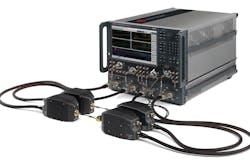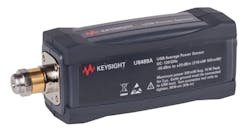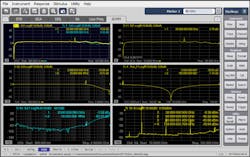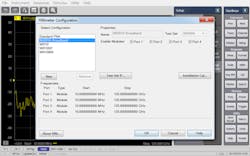Innovation Leads to Results in Millimeter-Wave Network Analysis
Download this article as a .PDF
The characterization and modeling of broadband devices presents many challenges, and these become more difficult as new-generation designs move up to millimeter-wave frequencies. When assessing a vector network analyzer (VNA), which is the most commonly used tool, the crucial attributes beyond single-sweep frequency range include stability and uncertainty across the entire measurement band.
A new solution is a broadband millimeter-wave network analyzer, which provides exceptional measurement performance with stability within 0.015 dB and 0.15° over a 24-hour period. Keysight Technologies’ N5290A and N5291A broadband millimeter-wave network analyzers cover a frequency range of 900 Hz to 120 GHz (Fig. 1). They leverage the company’s capabilities in terms of metrology and calibration, providing traceable, metrology-grade results across the full frequency range.
Innovating in Technology and Opening New Doors
Millimeter-wave technology has been around for decades, primarily in aerospace/defense and backhaul applications where the benefits have justified the high costs of development, manufacturing, and support. More recently, advancements in fabrication have been driving down the cost of extremely high frequency (EHF) devices, making them more viable in commercial and consumer applications. For example, developers using complementary metal-oxide semiconductor (CMOS) technology have produced devices with fT greater than 500 GHz, and some are aiming to extend this cost-effective technology into the terahertz (THz) range.
Keysight is among the firms developing EHF components. The company’s in-house capabilities in microwave semiconductor technology have led to the creation of a next-generation indium-phosphide (InP) process that supports transistor switching frequencies above 300 GHz. This makes it possible to achieve wider bandwidth in the integrated circuits (ICs) used in test equipment and other devices.
Overcoming the Obstacles to Better Measurements
Two key issues—guiding signals and generating power—are especially challenging in the creation of commercial, off-the-shelf test equipment that produces accurate, repeatable results at millimeter-wave frequencies. Waveguide is a crucial example, as it must be as close to perfect as possible to ensure proper internal operation of a millimeter-wave instrument. Managing signals between 100 GHz and 1 THz requires use of different waveguide bands. At such short wavelengths, any skew in a flange connection can cause unwanted reflections that will degrade signal quality and reduce signal power.
Generating adequate power levels is challenging because it is difficult to maintain amplifier efficiency and linearity simultaneously at these frequencies. This tends to limit the maximum power level that a signal generator or network analyzer can produce.
Once these problems have been solved, the next big issues concern calibration of the instrument and its surrounding test setup. It is difficult to accurately calibrate power levels at extremely high frequencies. However, precise control of power is essential to ensure measurement accuracy and avoid damage to the device-under-test (DUT).
For novices, millimeter-wave measurements may seem to involve a combination of art, science, and luck. In reality, engineers will benefit from a fresh start: set aside old habits, take a deliberate approach, and adjust all expectations. For example, it’s necessary to pay careful attention to every stage of a measurement setup: instruments, cables, and accessories. This means taking time to ensure pristine connections, clean upconversion of output signals, precise downconversion of incoming signals, low-level internal spurious signals, and well-managed internal harmonics. These factors are crucial to successful network analysis and the characterization of passive or active devices (S- or X-parameters, respectively).
Uniting the Essential Measurement Capabilities
Keysight has addressed these details with its new broadband millimeter-wave solutions. The measurement platform is a PNA or PNA-X VNA operating at either 26.5 or 67 GHz. The other core elements are a two- or four-port millimeter-wave test-set controller and a set of compact frequency extenders (“smart modules”). The latter include ruggedized 1.0-mm connectors, convection cooling, and built-in characterization data to enable fully calibrated port power at turn-on. To simplify benchtop measurements, engineers can mount the frequency extenders on an optional desktop positioner.
The new solutions produce measurements that are traceable to national measurement institutes. The foundation is a 1.0-mm calibration kit, and the result is traceable measurement uncertainty for key performance parameters such as residual calibration errors, system dynamic accuracy, and stability. A companion USB thermocouple power sensor (U8489A) covers a frequency range of dc to 120 GHz and simplifies source-power calibration with a 1.0-mm connector and single-connection convenience (Fig. 2). To further enhance measurement results, the user can choose to apply automatic fixture de-embedding to connectorized measurements or perform calibration at the probe tips to enhance the accuracy of on-wafer measurements.
Enhancing Stability and Precision with Mechanical Innovations
At millimeter-wave frequencies, the overall performance of a measurement system also depends on its physical and mechanical design. Inside the new smart modules, Keysight has applied advanced machining capabilities to fabricate wideband coupler technology that provides exceptional stability during measurement calibration.
In the test-set controllers and smart frequency-extender modules, ruggedized 1.0-mm test ports ensure repeatable connections from measurement to measurement, day after day. This reduces calibration uncertainty and further improves system-level measurement precision.
Testing Multiple Components in One Setup
New-generation monolithic microwave integrated circuits (MMICs) incorporate components that operate in different frequency ranges: baseband, RF, microwave, and millimeter-wave. A VNA with single-sweep coverage from Hz to GHz enables developers to test all those components in one test setup.
Wider frequency coverage also reduces the cost of the test solution. For example, a 900-Hz start frequency in a millimeter-wave network analyzer may eliminate the need to purchase a dedicated low-frequency VNA. An added benefit is this: The ability to use one analyzer saves time and reduces complexity by streamlining the development of test system software.
Greater integration inside MMICs and other wideband designs often means testing more functions per device through fewer access points. The need to connect, disconnect, and reconnect the DUT to a VNA or spectrum analyzer is inconvenient and time-consuming, whether done manually or automatically through a switch matrix.
The most convenient solution is a VNA with a single-connection/multiple-measurement (SCMM) architecture. As implemented in the PNA-X network analyzers, engineers can measure key characteristics of passive or active devices with one set of connections: S-parameters, noise figure, gain compression, total harmonic distortion, intermodulation distortion, and more. For additional versatility, the SCMM capability supports the PNA family’s spectrum analysis measurement application.
Simplifying Complex Tasks with Measurement Applications
To help users save time and easily configure complex tasks, measurement applications address specific tests and enable deeper insights into device performance. The capabilities include:
- Scalar mixer/converter measurements: Support scalar characterization of mixers and frequency converters
- Gain-compression application: Provides complete characterization of amplifiers and frequency converters
- Noise-figure measurements: Enable further characterization of frequency-converter performance
- Differential and I/Q devices application: Simplifies testing of amplifiers and mixers
- Spectrum analyzer application: Provides calibrated multi-channel spectrum analysis up to 120 GHz, or into the THz range with compatible frequency extenders
These measurement applications are also touch-enabled, further simplifying complex operations and providing an intuitive approach to investigating, characterizing, and troubleshooting broadband millimeter-wave devices (Fig. 3).
Leveraging a Common Platform
Good usability is beneficial when performing basic measurements such as S-parameters, and it becomes essential when delving into complex tasks such as the characterization of mixers and other frequency-conversion devices. To help ensure meaningful results in less time, many customers asked Keysight to build measurement guides into its instruments and to present those tools on the screen of the analyzer. This is an important concept, given the time pressures and design requirements most engineers face. It’s also a logical and feasible idea that utilizes the processor, memory, and display resources in the latest VNAs.
To address these needs, the Keysight design team pursued parallel development along two tracks: measurement performance and front-panel usability. To provide a foundation for next-generation Keysight VNAs, the development team created a common platform that leverages the best attributes of the established ENA and PNA network analyzer families.
Two guiding principles were paramount: Be inviting and intuitive for new users, but remain familiar and comfortable for existing users. The result is a graphical user interface (GUI) that is helpful to engineers who, from time to time, need to make a variety of measurements—simple or complex—while characterizing or troubleshooting a variety of RF components or subsystems. It is also useful to experienced users who occasionally need to make highly complex measurements and will benefit from reminders about the crucial steps and settings (Fig. 4).
All users will appreciate the familiarity of touch-enabled GUI technology akin to that used in smartphones, tablets, and laptops. The updates include the following attributes:
- 12.1-in. widescreen display with multi-touch GUI
- Easy access to frequently used functions
- Quick setups using touch-activated tabbed softkeys and dialog menus
- Intuitive single- and multi-touch gestures to drag-and-drop or magnify traces
- Versatile, touch-driven marker capabilities
For added flexibility, the user can also customize the placement of traces and windows on the analyzer screen. Example capabilities include optimal arrangement of traces from multiple measurement channels and multi-page measurement displays through a “tabbed sheet” function.
Taking the Mystique Out of Millimeter-Wave
The N5290A and N5291A broadband millimeter-wave solutions embody Keysight’s ongoing mission to provide easier access to accurate, repeatable measurements at ever-higher frequencies and wider bandwidths. Built on a foundation of electronic and mechanical innovations, the N5290A and N5291A deliver metrology-grade precision that ensures exceptional system-level performance. With these tools, today’s developers can take the mystique out of millimeter-wave technology and confidently characterize and optimize their devices from 900 Hz to 120 GHz.





